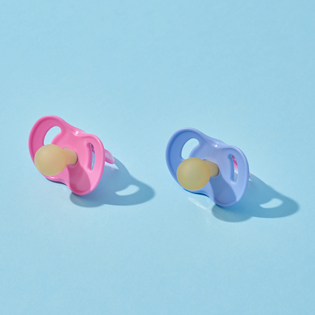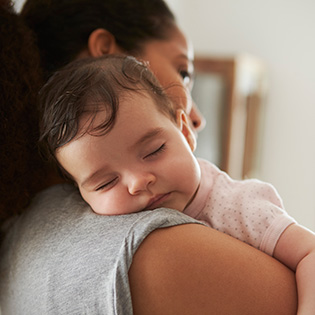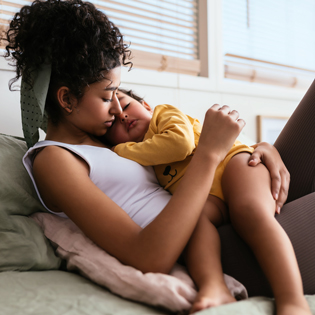Strep throat in toddlers and babies isn’t all that common. But it’s still possible for your little one to contract the infection, and if she does, it’s important for her to see her pediatrician.
Spotting a possible case of strep in kids under 3 isn’t always easy, though. Your little one may not yet be able to explain her symptoms. Plus, the signs of strep throat in young children can sometimes differ from the classic symptoms you’d look for (or may have experienced yourself).
So, how can you spot the infection and get your sweetie the care she needs? Here are some of the most common signs of strep throat in babies, toddlers and young children, when to call the doctor and what you can do to get your little one on the road to recovery fast.
What is strep throat?
Strep throat is a common bacterial infection. Caused by group A streptococcus bacteria, strep accounts for around a third of all sore throat illnesses in children.
Strep throat is highly contagious and anyone can get it. But it’s most common in kids aged 5 to 15, especially in late winter and early spring, when they’re more likely to be cooped up in close quarters.[1]
As for babies and toddlers? You shouldn’t worry too much about strep, since it’s extremely uncommon in infants and very young children. But since strep symptoms can differ for this age set, it’s especially important to know how to recognize a possible case so your little one can get tested and, if needed, start treatment.
What causes strep throat in children?
Strep is caused by the group A streptococcus bacteria, and as you’ve likely experienced yourself at some point, it spreads like wildfire.
Strep is most often transmitted through coughing or sneezing, but children (and adults) can also possibly get strep from sharing food or drinks with an infected person or touching a contaminated surface.
Read This Next
What’s more, a child with strep can be contagious for some time. Though infected babies and toddlers are most likely to spread strep when their symptoms are worst, strep can be passed on to others for up to three weeks.
Can babies get strep throat?
Anyone can get strep, including babies and toddlers. But it’s extremely uncommon in very young kids and is much more likely to affect those ages 5 to 15.
In the rare cases when babies and toddlers do get strep throat, their symptoms don’t always match up with what older kids and adults experience. So it’s important to know what to look for.
Strep throat signs and symptoms in children
What are the clues that your child might have strep? The symptoms are different for different age groups.
Strep throat in babies
Infants tend to exhibit:
- A low-grade fever
- Fussiness
- Poor appetite
Strep throat in toddlers
Toddlers with strep throat may have symptoms like:
- A moderate fever
- Prolonged runny nose, fussiness and poor appetite
- Stomach pain
- Vomiting
- Swollen neck glands
Strep throat in kids over 3
Children in the preschool or school-aged set tend to show classic signs of strep throat. These can include:
- A very sore throat that comes on quickly
- Pain while swallowing
- Fever
- Tonsils that are red, swollen or streaked with pus
- Scarlet fever (a red, sandpaper-like rash that can develop alongside strep)
Of course, not every sore throat is a case of strep.
How is strep diagnosed in children?
Call the doctor right away if you think that your sweetie might have strep. The pediatrician can conduct a rapid strep test, which involves using a cotton swab to collect a sample of the bacteria living on the tonsils and the back of your child’s throat.[2]
The test can be a little uncomfortable (for both of you), but it only takes a few seconds to swab the tonsils and throat — and you’ll get the results within five minutes.
If your child tests positive, the doctor may prescribe a standard 10-day course of antibiotics to treat the strep. If she tests negative, the cause of the sore throat is likely viral, so no antibiotics are needed.
Depending on your little one’s symptoms and their severity, the pediatrician might send the sample to a lab for a throat culture. You’ll get the results of that test within a few days. It's safe to wait until the results of the culture come back before starting antibiotics, and if the results do come back positive, it's important to treat with antibiotics even if your child feels better.
Symptoms of strep throat usually resolve in three to five days without treatment. However, doctors are careful to diagnose and treat strep to prevent rheumatic fever, a somewhat uncommon but dangerous complication. Because children under 3 are less likely to get strep throat and rarely get rheumatic fever, most experts recommend not culturing throats for strep in children under 3.
If your child displays symptoms of strep throat, you should still see a pediatrician even if your little one is feeling better after a few days, since treating at that point will still effectively prevent rheumatic fever.
How can you help soothe your child’s strep throat?
If your doctor has prescribed a course of antibiotics, your little one will likely begin to feel better within 24 hours of starting her meds (and she won’t be contagious anymore). Her symptoms will improve even more by day two or three. It's still important to complete the full course of antibiotics, even if she starts feeling better.
While you wait for the antibiotics to work, try to keep your patient comfortable and prevent her from becoming dehydrated.
- Offer liquids, like water, diluted apple juice or warm chicken broth. Avoid acidic juices like orange or grapefruit, which can irritate the throat.
- Offer cold or soft foods, like popsicles, yogurt, cottage cheese or scrambled eggs if she’s hungry. Steer clear of anything citrusy, acidic, spicy or salty, since they can be irritating.
- Run a cool-mist humidifier. The moist air may help ease a dry and itchy throat.
- Treat her fever. If your child has a fever, ask the pediatrician about giving acetaminophen (Tylenol) to a feverish baby 2 months or older, or ibuprofen (Motrin or Advil) to a child 6 months or older. Be sure to follow the dosing instructions on the label, and never give medication to babies under 2 months old without consulting your pediatrician first.
When to call the doctor
Since strep is unlikely but still possible in babies and toddlers, pay attention when your little one is under the weather and give the doctor a call if you suspect she has it.
Also call if she has other symptoms such as:
- Persistent fever
- Stiff neck
- Trouble breathing
- Lethargy
- Refusal to drink
- Decreased urination
- Rash
Remember, though, it’s likely that you won’t encounter a case of strep until your child reaches school age.











































 Trending On What to Expect
Trending On What to Expect





